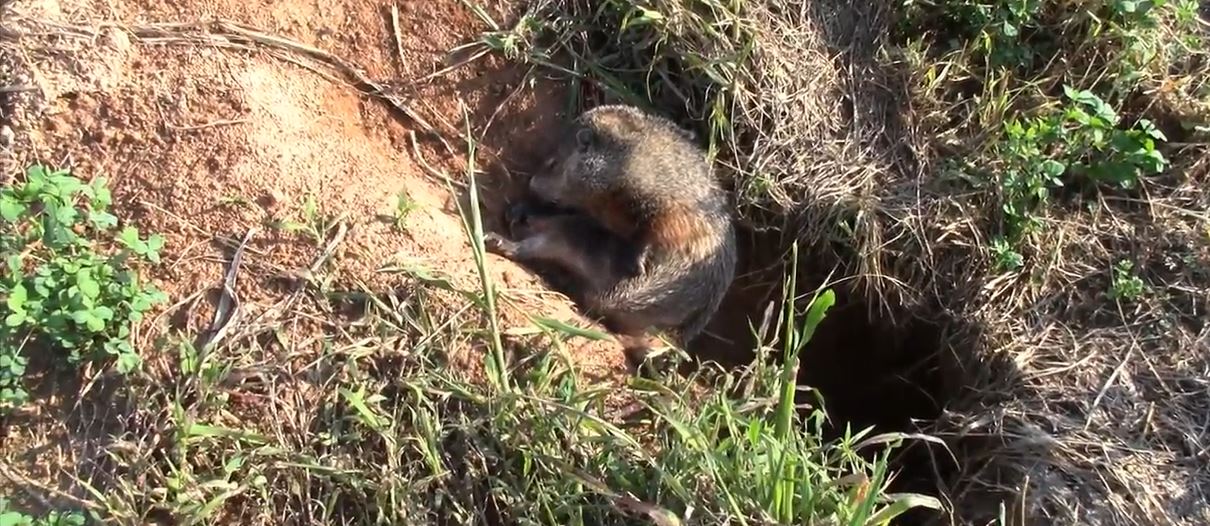How To Get A Groundhog Out From Under A Shed Or Porch

Groundhogs, also known as woodpeckers, typically live in burrows under the ground. When the opportunity arises, however, they will live in other similar areas, such as underneath your porch or shed. Most people don't want to have groundhogs on their property because they will uproot the dirt while searching for food and making their tunnels. If you already have one under your shed or porch, your best option to get rid of it is trapping and relocating by following these steps:
- 1. Buy a trap
- 2. Place and bait the trap
- 3. Watch the trap
- 4. Release the groundhog
- 5. Make repairs
- 6. Prevent re-entry
Instead of using a live trap, you can also buy a lethal one and skip step 4. To make this process easier, you can also hire a professional to help you. They will already have the trap on hand and know how to set it up and where to relocate the groundhog. If you want to do the job yourself, here is more information on each of the steps.
Buying Live Traps
There are two main types of traps for catching groundhogs: live and lethal ones. Before you trap and relocate the groundhog, you will want to check your local regulations to make sure you don't break the law.
Most people will choose to use a cage trap since this is a clean method. The trap is triggered when the groundhog enters and this makes the door close automatically. You can find a range of sizes, but for woodchucks, you should try to get one that is about a foot tall and two and a half feet long.
Buying Lethal Traps
If you choose to use a lethal trap, they will typically be spring loaded. These traps snap shut on the animal's body. Keep in mind that if you use a lethal trap, you will have to dispose of the groundhog's carcass and take care so a cat or other animal isn't caught.
Setting Up And Baiting The Trap
Consider using cantaloupe as bait for a groundhog. The animals enjoy this treat and it will tempt them to enter. Be sure to place some fruit just outside the trap as well and you can also use strawberries, sweet corn, or vanilla extract. To correctly place the trap, find the area that the animal is using to enter and exit the area under your porch or shed. Then place the trap immediately outside this area since this will increase the chances of the animal accidentally entering or being tempted by the food. If you can't put the trap directly outside the porch, you can create a path with wooden planks that lead the animal to the trap.
Tips For Handling The Groundhog
Whenever you handle a groundhog, you want to exercise extreme caution. These animals can carry diseases and have sharp teeth so you should avoid contact. Wear gloves and if you use a lethal trap, double bag the animal. If you used a live trap, put a blanket on top of the trap to calm down the groundhog. Then, you can take it to the relocation area.
Groundhog Repairs And Prevention
Depending on how long the groundhog you just removed has been living underneath your shed or porch, it may have moved 700 pounds of dirt! Unfortunately, the average person can't typically tell how much damage the woodchuck did, so you will probably want to consult an expert to evaluate the situation. If you feel confident in your abilities, feel free to roam around under the porch and put the dirt back where it belongs.
Remember that a new groundhog can easily move back into the area under your porch or shed unless you make some changes. The most effective method of preventing a groundhog is to install a fence around the area you want it to stay out of, in this case, underneath your shed or porch. Because groundhogs are great diggers, make sure that you embed the fence at least 18 inches, preferably two feet, underneath the ground. Make sure the bottom curves outward. Otherwise, a new groundhog will simply dig underneath the fence and enjoy its new home.
Don't Try A Repellent
Looking online or in the store will show you plenty of groundhog “repellents” that claim to work, but none will actually do the trick. Instead of wasting money on an ultrasonic sound machine, predator urine, or another repellent, follow the steps above and get the groundhog out from under your porch successfully.
What Else Not To Do
If there is a groundhog under your porch, you may be tempted to get it out as soon as possible. For many people, the natural instinct is to seal or dig out the burrow. The issue with this, however, is that these animals are very defensive of their homes. If you dig into their burrow, they are likely to become aggressive and attack you with their sharp teeth. Sealing up the burrow is pointless as the animal will simply dig a new entrance.
Read the How to get rid of groundhogs page for helpful information and to learn more about How To Get A Groundhog Out From Under A Shed Or Porch

